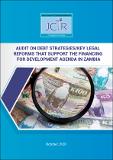| dc.contributor.author | Mbewe, Kalikeka;Shebo, Nalishebo | |
| dc.date.accessioned | 2022-05-23T10:22:05Z | |
| dc.date.available | 2022-05-23T10:22:05Z | |
| dc.date.issued | 2021-10 | |
| dc.identifier.citation | JCTR (2021). Audit on Debt Strategies/Key Legal Reforms That Support the Finance for Development Agenda in Zambia. Lusaka, Zambia: Jesuit Centre for Theological Reflection (JCTR) | en |
| dc.identifier.uri | https://repository.jctr.org.zm/handle/20.500.14274/239 | |
| dc.description | Over the past decade, Zambia has increasingly relied on non-concessional borrowing for development finance. This has changed the face of debt. As Zambia transitioned from a low income to a lower middle-income country in 2011, its borrowing options opened up and the country was able to participate in commercial debt markets. In 2012, 2014 and 2015, the country borrowed US$750 million, US$1.0 billion and US$1.25 billion, respectively, rapidly raking up a total (commercial) Eurobond debt of US$3.0 billion in less than 5 years. Other commercial loans obtained from commercial banks and other financial institutions such as the China Commercial Bank also came online. As the proportion of commercial debt in the total debt profile grew, so too did the debt
service costs the country faced. The rise in public debt has had adverse effects on inflation, exchange rates and ultimately growth,
as well as reducing fiscal space for critical social spending. Further, the economy has been characterised by high fiscal deficits due to the expansionary fiscal path that has been maintained. As a result of the widening and perpetual fiscal deficit, the authorities have had to borrow more to finance the deficit. | en |
| dc.description.abstract | Debt has been a major source of development finance for Zambia since independence in 1964. In the last decade, the country has been on a steep learning curve, moving from largely concessional borrowing to non-concessional and more market-based financing. Over the years, the complexion of debt has changed from largely bilateral and multilateral concessional debt to semi- and non-concessional suppliers’ credit and commercial debt. As a result, debt management has become more sophisticated and includes using debt transactions such as debt swaps and buy-backs and more detailed modelling of costs and risks as well as macroeconomic and market conditions. However, the Government is yet to use these instruments. With principal paybacks of the Eurobond debt during 2022- 2027, these avenues present both opportunities and challenges for Zambia as it considers
these options for managing its debt portfolio in the coming years. | en |
| dc.language.iso | en | en |
| dc.publisher | Jesuit Centre for Theological Reflection | en |
| dc.rights | Attribution-NonCommercial-ShareAlike 3.0 United States | * |
| dc.rights.uri | http://creativecommons.org/licenses/by-nc-sa/3.0/us/ | * |
| dc.subject | Debt Strategies;Debt Reforms;Finance Development | en |
| dc.title | Audit on Debt Strategies/Key Legal Reforms That Support The Financing For Development Agenda in Zambia | en |
| dc.type | Booklet | en |

